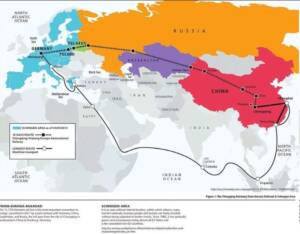In a bold move underscoring escalating tensions on Europe’s eastern flank, Poland has refused to reopen its border with Belarus, effectively halting a vital artery of the “New Silk Road” trade corridor between China and the European Union.
This decision has suspended a €25 billion annual rail freight route, disrupting the flow of goods that powers platforms like Temu and Shein, and drawing sharp rebukes from Beijing.
The closure stems from a confluence of security concerns, including the ongoing Zapad 2025 military exercises jointly conducted by Russia and Belarus, and a recent incident involving a Russian drone near Polish territory.
Approximately 90% of China-EU rail freight traverses this Belarus-Poland corridor, making it a linchpin of the Belt and Road Initiative’s European extension. With the border now sealed indefinitely, the ripple effects are already being felt across global supply chains.
The New Silk Road’s Critical Role
Launched as part of China’s ambitious Belt and Road Initiative, the New Silk Road has revolutionized Eurasian trade by linking Asia’s manufacturing hubs directly to European markets via high-speed rail networks. The route through Belarus and Poland has emerged as the dominant pathway, handling the bulk of container shipments that bypass traditional sea routes.
According to reports, this corridor alone facilitates up to 90% of all rail-based cargo between China and the EU, underscoring its unparalleled importance.

The annual trade volume—estimated at €25 billion—encompasses everything from electronics and apparel to industrial components. E-commerce giants like Temu and Shein, which rely heavily on affordable, rapid shipping from Chinese factories, have benefited immensely from this efficient overland path. However, the suspension threatens delays, increased costs, and potential shortages in European retail sectors.
Politico highlighted the corridor’s centrality in a recent analysis, noting that its disruption could exacerbate existing supply chain vulnerabilities in the post-pandemic era.
The Spark: Military Exercises and Border Incidents
The immediate trigger for Poland’s stance was the Zapad 2025 exercises, a massive joint military drill between Russia and Belarus that has raised alarms across NATO. These maneuvers, simulating large-scale warfare, have been criticized as provocative, especially given Belarusian President Alexander Lukashenko’s alignment with Moscow amid the ongoing Ukraine conflict.
Compounding these concerns was a recent incursion by a Russian drone into Polish airspace, which Warsaw viewed as a direct threat to national security. Polish authorities cited these events as justification for maintaining the border closure, which was initially imposed earlier this year.
In response to diplomatic overtures from Beijing urging a swift reopening, Polish Foreign Minister Radosław Sikorski engaged in three hours of intensive talks. However, Sikorski firmly rejected the request, emphasizing Poland’s sovereignty and the need for de-escalation on its borders.
Poland’s Demands: Ending Hybrid Warfare and Releasing Detainees
Poland’s position is not merely reactive; it is rooted in a broader demand for accountability from the Lukashenko regime. Warsaw has accused Minsk of orchestrating “hybrid attacks”—including migrant pushes, cyberattacks, and disinformation campaigns—aimed at destabilizing the EU’s eastern borders. These tactics, which intensified following Belarus’s support for Russia’s invasion of Ukraine, have strained relations to a breaking point.
Furthermore, Poland is calling for the immediate release of Polish citizens currently detained in Belarusian prisons on what it deems politically motivated charges. “The Lukashenko regime must end its hybrid aggression and respect basic human rights before any normalization of trade can occur,” a Polish government spokesperson stated.
This hardline approach aligns with broader EU strategies to counter Russian and Belarusian influence, but it risks isolating Poland economically in the short term. Alternative routes, such as those through Kazakhstan or the Baltic states, exist but lack the capacity and efficiency of the Polish corridor.
Beijing’s Frustration and Global Implications
China, which has invested billions in the Belt and Road, expressed deep disappointment over the impasse. Beijing views the New Silk Road as a cornerstone of its economic diplomacy and has urged all parties to prioritize commerce over confrontation. The suspension not only hampers Chinese exporters but also affects European importers dependent on just-in-time deliveries.
The fallout could extend beyond bilateral ties. With global trade already fragile due to geopolitical uncertainties, this blockade may accelerate diversification efforts, potentially benefit maritime routes, or even prompt shifts toward nearshoring in Europe. For consumers, it spells higher prices and delays for budget-friendly goods from platforms like Temu and Shein.
As the border remains closed indefinitely, stakeholders on both sides of the Eurasian divide are left grappling with the consequences. Poland’s stand signals a willingness to sacrifice economic gains for security imperatives, but at what long-term cost? Only time will tell if diplomacy can untangle this knot in the Silk Road.
Poland blocks Belarus border, halting €25B New Silk Road corridor and 90% of China-EU rail freight amid Zapad 2025 drills and Russian drone incursion. Warsaw demands an end to hybrid attacks and the release of detainees, disrupting Temu and Shein’s supply chains.







